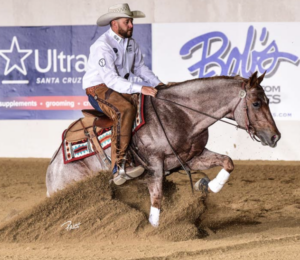An open field turn done well is a credit maneuver and using a baby sitter in your arena to help your young horse become more accepting of cattle pushing on him will help build his confidence.
Clayton Edsall of Oakdale, CA shares how he uses a baby sitter to his advantage. Cattle are herd animals and bringing in a large quiet cow or steer to sit in the center can serve as a magnet for the cattle he is using to train his colts on.
Before Edsall works a horse on a cow, he ensures they are properly warmed up by working on areas that he will need to put the horse in once he is working a cow.
“Before I put them on a cow a lot of times I will kind of work on some of the stuff and the position I am going to need to put him in to work the cow so that when I do put him on one, the cow isn’t the reason they are getting trained on. Then hopefully when I get them next to that cow and they are warmed up and they are soft, the cow becomes a safe or comforting place for him,” Edsall explained.
“Sometimes people get real afraid of the struggle to find that spot, but for me, if a horse doesn’t get into too much trouble when he is out of position, then he is going to keep his head about him and keep thinking about finding that spot. I don’t worry much about the bad spots too much, because to me they have to go through that struggle and then find that safe spot or the spot that I am trying to put them on a cow.”
Edsall emphasized how important it is to teach a horse to rate a cow from all sides.
“A lot of times in the beginning we teach a horse to rate from behind and then when we get to the fence work or the circling we lose a lot of rate because the horse gets out of his comfort zone and we are trying to force the cow to turn or we are trying to force our horse to turn the cow, or the cow is afraid or the horse is afraid, so in the start I like to think back to the beginning when I am just working a colt tracking and we don’t get too concerned about the distance or them getting up into the cow. We just keep working them and pretty soon they are wanting to find that spot,” he said.
 “When circling I kind of have an idea of where I want to stick them on that cow. Say for instance it is six feet away, it could be two or four, or whatever I decide I want, or even whatever the cow decides it will let me circle it, if the horse wavers in and out to get close or away from the cow I just keep making it uncomfortable until he starts to find that spot where I want him to be on the cow,” said Edsall.
“When circling I kind of have an idea of where I want to stick them on that cow. Say for instance it is six feet away, it could be two or four, or whatever I decide I want, or even whatever the cow decides it will let me circle it, if the horse wavers in and out to get close or away from the cow I just keep making it uncomfortable until he starts to find that spot where I want him to be on the cow,” said Edsall.
By using a slower cow at the beginning and getting his horse used to running along with the cow, rating it down the long wall and stopping and backing, he can see if his colt will allow the cow to push on him a little bit.
While teaching the colt to hunt the correct spot on a cow, Edsall explained, “I am trying to get him used to running to a spot up on the cow, and when he falls out of that spot, I will just run him back into the correct spot. I always want him hunting that spot and make sure you set the colt up to find something he is confident at.”
By early spring of the three-year-old year, Edsall said, “I have not run them down the fence a lot, but what I have done is parts of the fence work, some in the two-year-old year and some into the three-year-old year so they should know a little bit about circling and a little bit about turning on the fence, but I haven’t put a lot of it together.”
By putting the baby sitter in the middle of the pen, Edsall is wanting the cattle to pull away from the fence and get the horses use to having cattle coming up against them.
“When I go to circling them usually, they will go to the middle and circle around the baby sitter and I will have a good opportunity to teach some circling.”
